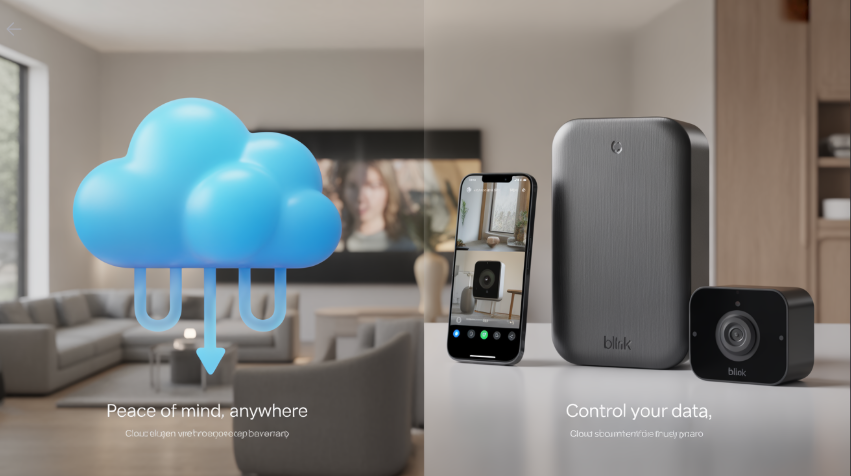
When it comes to securing your home with Blink cameras, you have two main storage options: cloud storage and local storage. But which one is the best for you? The answer depends on your specific needs. If you want remote access and automatic backups, cloud storage is a great choice. However, if you prefer to avoid monthly fees and keep your footage private, local storage might be the better option.
Blink Cloud vs. Local Storage: Key Differences
What is Blink Cloud Storage?
Blink Cloud Storage is an online storage service provided by Amazon, the company behind Blink cameras. Your recorded videos are uploaded to Blink’s secure cloud servers and can be accessed anytime through the Blink app.
Pros of Blink Cloud Storage
✅ Easy Access Anywhere – View your footage from anywhere with an internet connection. ✅ No Risk of Physical Damage – No worries about losing videos due to hardware failure or theft. ✅ Automatic Storage Management – Old recordings are deleted automatically to free up space. ✅ Multiple Device Syncing – Access footage on multiple devices, including your phone, tablet, or PC. ✅ Secure Amazon Servers – Your videos are stored on Amazon’s highly secure servers.
Cons of Blink Cloud Storage
❌ Subscription Fee – Requires a monthly or yearly payment. ❌ Internet Dependency – Without the internet, videos won’t upload or be accessible. ❌ Limited Storage Duration – Older footage is automatically deleted after a set period (depending on your plan). ❌ Potential Privacy Concerns – Since videos are stored on external servers, some users may worry about data security.
What is Blink Local Storage?
Blink Local Storage lets you save recorded videos on a USB drive connected to the Blink Sync Module 2. Instead of storing videos in the cloud, they are kept locally on your device.
Pros of Blink Local Storage
✅ No Monthly Fees – One-time cost for the USB drive, with no recurring payments. ✅ Full Control Over Footage – Keep recordings for as long as you want without automatic deletion. ✅ Works Without Internet – Video storage continues even if your internet goes down. ✅ More Privacy – No need to upload videos to an external cloud, reducing privacy risks. ✅ Expandable Storage – You can upgrade to a larger USB drive for more storage capacity.
Cons of Blink Local Storage
❌ Limited Access – You must manually access the USB drive to review older footage. ❌ Risk of Damage or Theft – If the USB drive is damaged or stolen, you lose all recordings. ❌ Manual Storage Management – You must delete old recordings when space runs out. ❌ No Automatic Backups – If something happens to your USB drive, you cannot recover lost footage.
Blink Cloud vs. Local Storage: Key Differences
| Feature | Blink Cloud Storage | Blink Local Storage |
|---|---|---|
| Cost | Requires subscription | One-time cost (USB drive) |
| Storage Limit | Limited (depends on plan) | Depends on USB drive size |
| Internet Needed? | Yes | No |
| Access to Footage | Anywhere via app | Only through USB drive |
| Security | Stored on Amazon’s servers | Stored locally, risk of loss |
| Automatic Backups | Yes | No |
| Privacy Control | Limited | Full control over data |
Which Storage Option is Best for You?
Your choice depends on your needs:
- Go for Blink Cloud Storage if: You want easy remote access, automatic management, secure backups, and don’t mind paying a subscription.
- Choose Blink Local Storage if: You prefer a one-time purchase, want full control over recordings, need offline functionality, and prioritize privacy.
Can You Use Both Cloud and Local Storage Together?
Yes! If you have a Blink Sync Module 2, you can store videos locally while still using cloud storage. This gives you the best of both worlds—cloud convenience with local backup.
Both Blink Cloud and Local Storage have their pros and cons. If convenience, remote access, and automatic backups are your priorities, cloud storage is the way to go. But if you want to avoid fees and have complete control over your recordings, local storage is a great option. Either way, you’ll have a reliable way to store your security footage.
Which one do you prefer? Let me know in the comments below!
Frequently Asked Questions About Blink Storage
1. Can I use Blink cameras without a subscription?
Yes, you can use Blink cameras without a subscription, but you will need a Blink Sync Module 2 with a USB drive for local storage.
2. How much does Blink Cloud Storage cost?
Blink offers a subscription plan called the Blink Plus Plan, which starts at around $3 per month per camera or $10 per month for unlimited cameras at one location.
3. What happens when Blink Cloud Storage is full?
Older footage is automatically deleted to make space for new recordings, based on the storage limit of your subscription plan.
4. What size USB drive do I need for Blink Local Storage?
Blink recommends using a USB 2.0 or 3.0 flash drive with at least 1GB of storage, but it can support up to 256GB.
5. Can I switch from Blink Cloud Storage to Local Storage?
Yes, you can change your storage settings in the Blink app and connect a USB drive to your Blink Sync Module 2 to enable local storage.
6. Is my footage safe with Blink Cloud Storage?
Yes, Blink Cloud Storage is encrypted and stored on Amazon’s secure servers. However, privacy-conscious users may prefer local storage for full control over their data.
